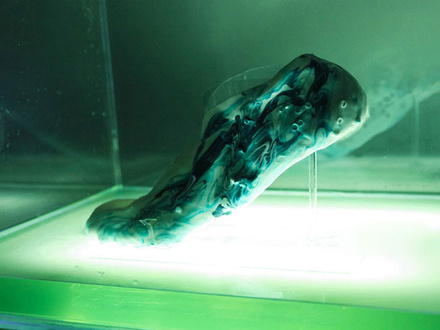Introducing 3D printing into the production of running shoes is not a new thing. Nike, Adidas have printed simple plastic soles from plastics, metals and other raw materials. However, Shamees Aden, a design and researcher in London, is more radical. He wants to use primitive cells as printing materials to make your running shoes have the function of self-healing.

At this year ’s Wearable Futures conference, researcher Shamees Aden proposed to use a synthetic biological material, that is, primitive cells as the raw material for 3D printing, to print a self-healing running shoe.
This running shoe concept is based on Aden's research on primitive cells. The basic primitive cell molecules do not have vitality themselves, but they can be combined to form a living body. Mixing different primitive cells can create different performance tissues. Under the conditions of different light, heat and pressure, a variety of biological coding.
The special biological materials are printed by 3D printing, so that the shoes fit the user's feet more perfectly, making the running shoes like the user's second skin.
According to Aden's introduction, these cell groups can expand and contract according to the force, to adapt to the user's running on different roads. According to different forces and movement trajectories, shoes provide additional cushioning.
Even more amazing is that after the user finishes running, the shoes can be placed in a container filled with liquid from the original cells. This liquid, like a charger and a stimulant, maintains the health of the living body in the shoe and helps it regain its vitality, allowing the shoe to repair itself at night. At the same time, this liquid can also be dyed in different colors, and shoes can also change colors overnight.
This is an interesting concept, it blurs the concept between biological and non-life problems, and promotes the boundary of 3D printing. But at present, it is still a conceptual product. Martin Hanczyc, a professor at the University of Southern Denmark, is also assisting Shamees Aden in tackling this technology. Aden expects running shoes to be available in 2050.
1. Renewable and Sustainable: Bagasse is a byproduct of sugarcane processing. It is made from the fibrous residue left after extracting the juice from sugarcane stalks. As sugarcane is a fast-growing plant, bagasse is a renewable and sustainable material.
2. Biodegradable: Bagasse is fully biodegradable, meaning it can break down naturally and return to the environment without causing harm. Unlike plastic containers, which can take hundreds of years to decompose, bagasse shushi tray can break down within a few months.
3. Reduced Carbon Footprint: The production of bagasse pulp containers requires less energy compared to plastic or Styrofoam containers. Bagasse is a natural material that does not require extensive processing or chemical treatments, reducing the carbon footprint associated with its production.
4. Waste Reduction: Sugarcane Bagasse sushi tray are made from a waste product of the sugarcane industry. By utilizing bagasse, these containers help reduce the amount of agricultural waste that would otherwise be discarded or burned, contributing to air pollution.
5. Compostable: Bagasse Pulp Container can be composted along with other organic waste. When properly composted, they can break down into nutrient-rich soil, contributing to the growth of plants and reducing the need for chemical fertilizers.
6. Non-toxic: Bagasse is a natural material and does not contain harmful chemicals or toxins. This makes bagasse containers a safe option for storing and serving food, without the risk of leaching harmful substances into the food.
Bagasse Pulp Sushi Container,Bagasse Sushi Tray,Pulp Sushi Container,Sugarcane Sushi Trays
EVER GREEN(ZHEJIANG)NEW MATERIAL CO., LTD / KUNSHAN GREENPACK CO.,LTD , https://www.changjingpack.com